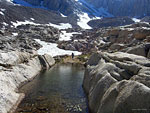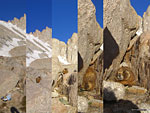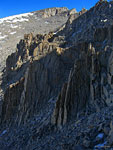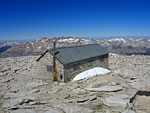 |
|
| Mt. Whitney Sierra Nevada, Inyo National Forest, California Climbing the highest peak in the lower 48 states |
Overview
| Mt. Whitney is one of numerous jagged peaks that form the massive north-south wall of the Eastern Sierra in Central California. With a vertical prominence (height above its surroundings) of over 12,000 ft., 14,500 ft. Whitney soars prodigiously above the flat plain of Owens Valley. The breathtaking panoramic view from the summit is like looking back at earth from an airliner. From north to south, the jagged ridges and deep, river and lake-filled plateaus and valleys of the Sierra Nevada stretch to infinity. To the west are the serrated peaks of the Great Western Divide. Across wide brown Owens Valley, the formidable high ridgeline of the White Range mirrors that of the Sierra. Many of the mountains in the surrounding eastern Sierra are also 13-14,000 ft., so Mt. Whitney doesn't stand out dramatically on the ridge. In fact, because it sits back slightly from the eastern Sierra front range, adjacent peaks like Mt. Muir actually appear taller unless you're on the summit. It's difficult to recognize which of the jagged peaks is Whitney, even after you've climbed it. Mt. Whitney, named after a state geologist, Josiah Whitney, is in the Inyo National Forest and managed by the US Forest Service. Although it's the highest peak in the contiguous USA, and a strenuous hike, climbing Mt. Whitney doesn't require technical skills or special gear. But you do need a permit and because of it's popularity, these can be challenging to score. The "Whitney Zone" is an extended area that begins above Lone Pine Lake where special rules are in force to prevent overuse, e.g. even dayhikers need a permit to enter. |
Most hikers reach the summit via the well-maintained trail from Whitney Portal, a concession area on the east side of the mountain with campgrounds, a store, a restaurant and trailhead parking. The trail from 7800 ft. Whitney Portal gains 6000 ft. of elevation over 11 miles for a round trip of 22 miles and 12000 feet of elevation change. The summit-and-back hike can be accomplished in one very long day, but most commonly, hikers spend the first day climbing to Trail Camp (12000 ft.), setting up camp and acclimatizing overnight, then summiting with a day pack and returning to Whitney Portal the following day. The western approach is usually via the John Muir Trail, which begins/ends 2 miles below the summit at Trail Crest. There are other entry trailheads from which to access these two trails and there are other established routes to the summit as well, among them the Mountaineers Route up the northeast face. |
Trip Report
I'd been looking forward to climbing Whitney for some time and had been reading up on the mountain, the climb and the red tape and preparing myself mentally. When the opportunity presented itself as an unplanned long July 4th weekend and perfect weather forecast, I make an impulse decision to hit the road and see if I can luck out walking in and scoring an unclaimed permit. I call and talk to a ranger about my chances for this and where to be at what time. I'm hopeful I'll get lucky, but will enjoy hiking elsewhere in the area if not. I'd been out backpacking several times already this summer, had been working out and jogging and I'm pretty sure I can handle the notoriously grueling 6000 ft. climb. What concerns me is altitude sickness, which seems to strike randomly to even well-prepared hikers. I've never experienced bad altitude sickness, but know the key is to arrive early to acclimate to the altitude before a summit bid, and drink plenty of water.
I pack my gear into the car the night before and set out after work for the 200 mile drive from LA, arriving in Lone Pine about 4 hours later. In order to be as close as possible to the permit station in the morning, I forego camping the first night and take a room at the Whitney Portal Hostel on Main St. in Lone Pine, a large, clean new building built by the same friendly people who manage the Whitney Portal Store up on the mountain. The place was relatively empty so I have a 6 cot room to myself. After a few hours socializing at Jake's Bar across the street with a fellow hostel guest —a cute babe who was way young for me— I turn in late.
| Day 2: Trail Camp to Summit to Whitney Portal 16 mi., +2500 ft. -6000 ft. | |||||||||
|
|||||||||
Trail / Conditions / Maps
| The trail from Whitney Portal to the summit of Mt. Whitney is approx. 11 miles with an elevation gain of 6000 ft. It's 6.3 mi. to Trail Camp and 4.7 mi. from Trail Camp to the summit at 14,496 ft. This is a strenuous, tough hike and will be much more enjoyable if your prepare yourself with a good cardio workout before attempting it. When to go The best hiking conditions are from mid-June to mid-September, when the most of the snow has melted and before the first Fall storms. There is snow and ice on Mt. Whitney year round at the higher elevations but usually just a handful of slippery places on the trail along the 97 switchbacks until August. The temperature on this July 4 hike went from high 80's at Lone Pine to low 40's at Trail Camp. With wind chill, it can get down below freezing year round. Acclimating Altitude sickness is a major concern and acclimatizing overnight at elevation is the best preparation. Commonly, hikers spend a day or two camping at Whitney Portal (8360 ft.), or a nearby area of similar elevation, and dayhiking so respiratory systems can adjust to the thinner air. Hiking to 12000 ft. Trail Camp for the first night worked for me and I had no problems. Drinking lots of water is reported to be helpful. |
Trekking poles are recommended
If you're hiking out the same day you summit, you should plan on leaving the summit before noon. Gear For 3 season hiking, you'll want a sleeping system that will keep you warm in temperatures down to freezing, even in the summer. Many people hike to the summit in short sleeves and shorts, but carrying extra layers and hat and gloves for a sudden storm is wise. Lugged sole shoes and trek poles will help on ice and snow. There's plenty of water to filter in streams and lakes along the trail year round, but no water above Trail Camp. Sunscreen is a must and a wide brimmed hat will keep you cool. |
Permits / Directions / Links
| Permits Climbing Mt. Whitney is one of the most popular hikes in the USA, so the US Forest Service has developed a complex quota system to restrict the flow to a certain number of entries per day for each access trailhead in the "Mt. Whitney Zone". If you can plan in advance, you'll have the best chance of climbing Whitney on your chosen date. For the Mt Whitney Zone, the permit reservation fee is $15.00 per person. The Mt. Whitney Lottery At the beginning of the season, permits are distributed via a lottery system and permit applicants are selected randomly from February through the end of March. Permit quota's for the most popular weekends of the season will usually get filled up during this lottery. Applications must have a February postmark - the final due date is Feb. 28 - if you wish to reserve a wilderness permit for a trip that begins between May 1 and November 1. Permit reservations are given out beginning Feb. 16. Permits must be picked up in person by the trip leader on the day before your hike or before 9:00 on the day of your hike at the USFS Visitor Center south of Lone Pine. Walk in permits The quota space for the Mt. Whitney trail is all reservable. Space is not saved or set aside for walk-in permits. However, cancellations and any space that was not filled by reservations will be available one day before the entry date at the Visitor Center south of Lone Pine. If you don't mind taking chances, you can try to score one of the walk-in permits by showing up at the Visitor Center the day of your hike. You have better chances of getting a permit if you are flexible with dates or have a smaller party. |
Other rules Bear resistant cannisters are required in the Mt. Whitney Zone and no fires are allowed. Human waste must be packed out in a provided WAG (Waste Alleviation and Gelling) bag, a layered, Ziploc-style plastic bag with a urine-activated powder to encapsulate and deodorize solid waste. According to the USFS website, Mt. Whitney visitors packed out over 3 tons of human waste in 2007. Whitney Portal is an active bear prowl area and all food, trash, toiletries and coolers are required to be removed from your parked vehicle and stored in provided bear steel bear boxes. Directions From Los Angeles to Mt. Whitney is 200 mi. north on I-5 to Hwy. 14 to Hwy. 395 to Lone Pine, CA.Whitney Portal Rd. begins in the middle of Lone Pine and goes west 8 miles up the mountain, where it ends at Whitney Portal. There are several large free parking lots with no time limit. The trailhead is through a wooden beam gateway structure on the north side of the road across from some toilets. |
|
| ||
Pictures
Getting there
 On the road west to Whitney Portal, the wall of the eastern Sierra rises up from the flat Owens Valley. Mt. Whitney appears much lower than the closer front range peaks. Whitney is pyramid-shaped with two chimney peaks to the left, directly above the first yellow dash in the road. |
 A wooden gateway marks the entrance to the Mt. Whitney trail |
 The path to Mt. Whitney climbs up this gap beyond a noisy waterfall |
 Looking back, a sliver of the last turn in the road up to Whitney Portal is visible center left |
 Lone Pine Lake is 1/8 mi. down an access path. A group of guys were doing flips off the rocks across the lake into the icy water. Brrrr |
||
 Twisty tree |
 Lone Pine Lake from up canyon |
 Big granite walls obscure the serrated ridge where Whitney lives |
 A waterfall near Bighorn Park |
 High walls on the way to Outpost Camp |
 Backpackers take a break in the shade of a grove of ancient trees |
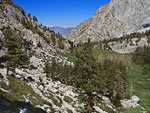 A hiker descends into Outpost Camp, the last big meadow |
 Emerald-colored Mirror Lake enclosed in a granite bowl |
 After a welcome respite in the cool shade of big trees around Mirror Lake, the trail climbs an exposed mound |
 The water that carved this impressive canyon seems to originate at this snow bank below a high basin The water that carved this impressive canyon seems to originate at this snow bank below a high basin |
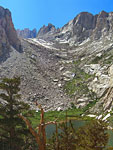 The serrated peaks of the Whitney ridge peek in |
|
 Climbing high above Mirror Lake |
 View east over the Outpost Camp meadow to the Owens Valley |
 Last look back at Mirror Lake and the granite mound just climbed |
 The stream sometimes hides under boulders and snow, sometime flows out in the open |
||
 Some of the last greenery at the edge of treeline Some of the last greenery at the edge of treeline |
 High ridges are soaring now. A cross-country hiker has left his footprints in the snowbank. |
 Consultation Lake in the south of the Trail Camp basin. You can make out a hiker, bottom of lake, left of center, standing on the rocks |
 A weary group makes the final push through snow to Trail Camp |
||
 A hiker on a boulder (center left) checks out the view. Most Trail Camp'ers set up near this lake-like strip of water. |
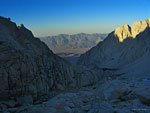 Dusk comes early to Trail Camp in the shadow of the Mt. Whitney ridgeline |
 Last light on Consultation Lake. You can see a light blue tent nestled in the rocks left of the sunlight reflection at bottom center |
 Dawn on the pond at Trail Camp |
||
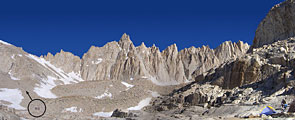 Morning of day 2, hikers start up the infamously steep 97 switchbacks. Mt. Whitney is out of frame to the right |
 Windblown snow drifts below the trail |
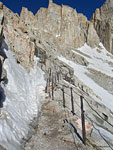 Like Yosemite's Halfdome, Whitney also has its "cables" |
 The cables traverse a notoriously icy spot above a looming dropoff. View east to Trail Camp and the valley up The cables traverse a notoriously icy spot above a looming dropoff. View east to Trail Camp and the valley up |
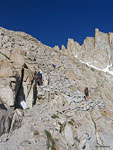 Hikers on a steep section of the 97 switchbacks |
|
 A marmot poses below the pointy peak of Mt. Muir |
 Another traverse of snow and ice |
 View east from atop the 97 switchbacks |
 Panorama east with Mt. Whitney (L) above the snow-streaked terrain of the Mountaineer's Route to Trail Camp (lake, center right). The rock in the center is Wutan's Throne. The trail from Whitney Portal came through the slot valley at center right. |
||
 The summit of Mt. Whitney is the flatter mountain just right of Mt. Muir, the pointed peak at center The summit of Mt. Whitney is the flatter mountain just right of Mt. Muir, the pointed peak at center |
 Just below Trail Crest, a last icy traverse above a half mile long 45 degree slope |
 At Trail Crest is the first view to the other side of the mountain |
 The trail enters deep morning shadow on the west side of Whitney. |
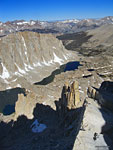 It's like looking out from inside a darkened theater |
|
 View north (R) and west (L) to the Hitchcock Lakes below 13184 ft. Mt. Hitchcock. Behind them in the distant center are the peaks of the Kaweah Range and the Great Western Divide. The John Muir Trail follows the wide valley at right and turns north to Forester Pass. |
 From inside the shadows, the brilliant colors of the western Sierra are luminous. From inside the shadows, the brilliant colors of the western Sierra are luminous. |
 It must be a mile almost straight down |
|||
 A hiker (far left) makes his way up through the rubble field that is the western side of Mt. Whitney |
 Smoke from a wildfire rises above ridges to the west |
 2 hikers (top left) on the west side of the Mt. Whitney trail through boulders and rubble |
 Several gaping chutes along the path offer a quick ride down |
||
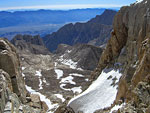 View east through the "windows" |
 Aptly named Guitar Lake |
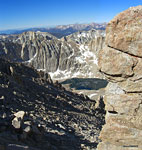 View SW over Hitchcock Lake |
 As the Whitney trail winds north around the final approach to the summit, more of the western Sierra comes into view. On it's way south from Yosemite to Mt. Whitney, the John Muir Trail skirts the banks of Guitar Lake (center right), the last lake on the trail. The neck of the guitar points through the gap to the Kaweah Range. Here are the Kaweahs from the other side, from my trip to the Great Western Divide. |
||
 West-southeast panorama from the summit of Mt. Whitney |
|||||
 Variations of this view, from 14495 ft., down to Lone Pine are visible throughout the hike up |
 View west (L) to east (R) at noon atop Mt. Whitney |
More photos in |
|||
TOP
Since 12.09



